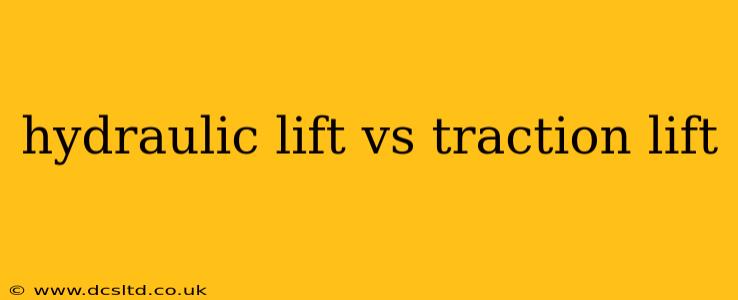Hydraulic Lift vs. Traction Lift: A Comprehensive Comparison
Choosing between a hydraulic lift and a traction lift for your elevator needs depends heavily on factors like building design, budget, and desired performance. Both systems achieve vertical transportation, but their mechanisms differ significantly, impacting efficiency, maintenance requirements, and overall cost. This comprehensive guide will dissect the key differences, helping you make an informed decision.
What is a Hydraulic Lift?
Hydraulic lifts use a piston-and-cylinder system powered by hydraulic fluid. The piston, located in a cylinder beneath the elevator cab, is driven upwards by pressurized hydraulic fluid. This fluid is pumped by a hydraulic power unit, located in a dedicated machine room. As the piston rises, it raises the elevator cab along with its passengers. Lowering is achieved by releasing the hydraulic pressure, allowing the weight of the cab to slowly descend.
What is a Traction Lift?
Traction lifts, conversely, utilize a system of cables and counterweights to move the elevator cab. A motor drives a sheave (a grooved wheel) that pulls the cables attached to the elevator cab. These cables move the cab vertically. Counterweights, roughly balancing the weight of the cab, minimize the power needed for vertical movement. This system is generally more efficient for taller buildings.
What are the Key Differences Between Hydraulic and Traction Lifts?
Here's a table summarizing the major differences:
| Feature | Hydraulic Lift | Traction Lift |
|---|---|---|
| Mechanism | Hydraulic piston and cylinder | Cables, counterweights, and a motor |
| Speed | Generally slower | Generally faster |
| Height Limit | Typically limited to lower-rise buildings (under 50 feet) | Suitable for high-rise buildings |
| Efficiency | Less efficient, especially in taller buildings | More efficient, especially in taller buildings |
| Maintenance | Can require more frequent maintenance | Usually requires less frequent maintenance |
| Cost | Typically lower initial installation cost | Typically higher initial installation cost |
| Space Required | Requires a pit and machine room | Requires a machine room (though potentially smaller) |
| Noise Level | Can be noisier | Generally quieter |
| Environmental Impact | Uses hydraulic fluid, which can be environmentally impactful if not properly managed | More environmentally friendly due to less reliance on hydraulic fluids |
How Much Does a Hydraulic Lift Cost?
The cost of a hydraulic lift varies significantly based on factors such as size, capacity, features, and installation location. However, generally speaking, they tend to have a lower initial cost compared to traction lifts.
How Much Does a Traction Lift Cost?
Similarly, traction lift costs depend on numerous factors. Their complexity and the need for more advanced components usually result in a higher upfront investment than hydraulic lifts.
Which Type of Lift is Best for My Needs?
The best lift type depends on your specific needs:
- Low-rise buildings (under 50 feet): Hydraulic lifts are often a cost-effective choice.
- High-rise buildings (over 50 feet): Traction lifts are generally more efficient and suitable for higher speeds and greater heights.
- Budget constraints: Hydraulic lifts often have a lower initial investment.
- Energy efficiency: Traction lifts generally offer better energy efficiency.
- Maintenance budget: Traction lifts tend to require less frequent maintenance.
What are the Advantages and Disadvantages of Each Type?
Hydraulic Lift Advantages:
- Lower initial cost.
- Simpler design and maintenance (for smaller applications).
- Suitable for low-rise buildings.
Hydraulic Lift Disadvantages:
- Less efficient than traction lifts.
- Slower speeds.
- Can be noisy.
- Environmental concerns with hydraulic fluid disposal.
- Limited height capabilities.
Traction Lift Advantages:
- Higher speeds.
- Greater capacity and height capabilities.
- More energy-efficient.
- Quieter operation.
- Less frequent maintenance (generally).
Traction Lift Disadvantages:
- Higher initial cost.
- More complex design and maintenance (for larger/complex applications).
- Requires more space for the machine room.
By carefully considering these factors and consulting with elevator professionals, you can choose the lift system that best meets your building’s requirements and budget. Remember, this is a general overview, and individual circumstances may warrant further investigation.
